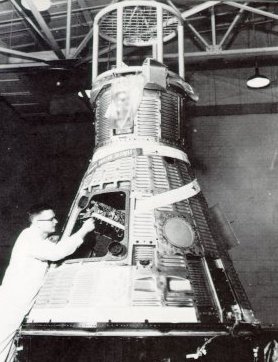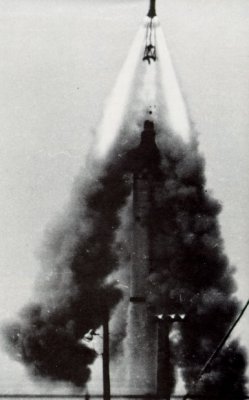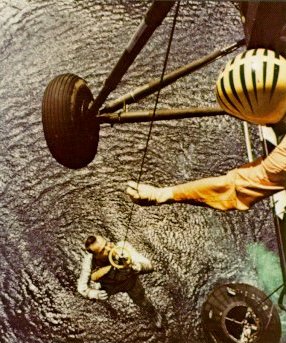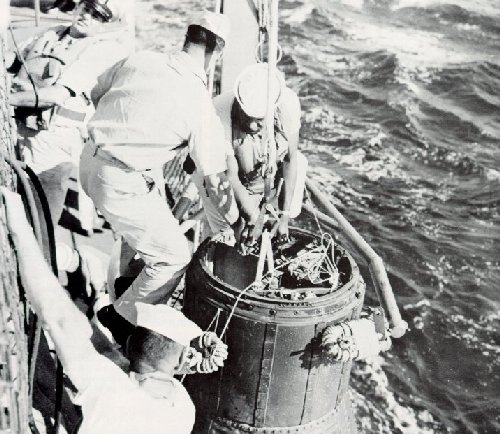
THE YEAR OF DECISIONS (JUNE 1961 TO JUNE 1962)
The twelve months following the decision to go to the Moon saw the complete plan unfold. New Centers were created, roles and missions were assigned, and the basic designs for the launch vehicle and spacecraft were agreed upon. In addition, a vital new program, called Gemini, was instituted to explore rendezvous, docking, and the many other factors that were vital before Apollo could set out.

| Tiny one-man spacecraft -then called capsules- orbited the Earth in the Mercury program. They were checked out in a hangar at Cape Canaveral before being hoisted up and mated with a launch vehicle. Heat-resistant shingles covered the afterbody. |
At the onset of the program, there were two government groups eager to participate. There was the Marshall Space Flight Center under Dr. Wernher von Braun, which was a mature center having more than 5000 people, and there was the small but expert Space Task Group of only a few hundred people, a group already severely loaded with the Mercury project. Mr. Webb, the Administrator, Dr. Dryden, the Deputy Administrator, and Dr. Seamans, the Associate Administrator, were the top management of the agency, and they brought onboard a young man named Brainerd Holmes to head the manned spaceflight effort in Washington. This group lost little time in deciding roles and missions for the lunar program. A new launch center was created in Florida, and Dr. Kurt Debus, formerly of Marshall, was named its head. The Marshall Center got the job of developing the huge Moon rockets, although the size of the rocket and the mode for going to the Moon had not yet been decided. The decision was made to expand the Space Task Group into a full NASA Center and assign it the job of developing the spacecraft and of creating a complex of technical facilities for spacecraft research and development, astronaut training, and flight operations. I became head of this new NASA Center in Houston. The Center facilities were authorized by Congress, but they did not yet exist. And so during the first year of Apollo the Space Task Group became the Manned Spacecraft Center and moved from Virginia to Texas. We occupied some 50-odd rented buildings while the new Center was being designed and built. It was a period of growth, organization, and growing pains. We were establishing new contractor relations, moving families and acquiring new homes, as well as conducting the orbital flights of Project Mcrcury.

| Boiler plate models (below) of escape tower and spacecraft were tested with Little Joe boosters at Wallops Station. Little Joe could briefly deliver up to 250,000 pounds of thrust from eight solid-fuel rockets. These launches were in 1959 and 1960. |
Many of the key ideas and designs for going to the Moon were created during this period of upheaval, turmoil, and the stress of major flight activities. Even before the President's decision to land on the Moon, we had been working on designs and guidelines for a manned circumlunar mission. This was done in a series of bull sessions on how we would design the spaceship for this purpose if the opportunity occurred. Our key people would get together evenings, weekends, or whenever we could to discuss such questions as crew size and other fundamental design factors. We believed that we would need three men on the trip to do all the work required, even before the complexity of the landing was added. We believed that man would be able to stand a zero-gravity environment for the time required to go to the Moon and return. We had decided that an oxygen atmosphere of 5 pounds per square inch was the best engineering compromise for a system that would permit extravehicular activity without another module for an airlock. Other basic decisions included the selection of an onboard navigation system as well as the ground-based system, and controlled reentry to reduce g-loads and give pinpoint landings. These original guidelines for lunar flight were presented to all NASA Centers and to the aerospace industry.

| Maximum public embarrassment in the Mercury program occurred in the inadvertent "tower flight". A circuit quirk cut off the Redstone's engines inches after liftoff. It was just enough to trigger the escape sequence. The engineers could explain it, but the public inevitably wondered if we were really ready to send a man safely into space. |
The conceptual design of the moonship was done in two phases. The command and service module evolved first as part of our circumlunar studies, and the lunar lander was added later after the mode decision was made. We were extremely fortunate that the design that evolved had such intrinsic merit. We had designed our circumlunar spaceship to have a command module containing the flight crew located on top of the stack, so that the astronauts could escape by means of an escape tower if abort were necessary during launch. The service module containing fuel for space propulsion, elec- tric power equipment, and other stores, was underneath it with its big rocket and its maneuvering systems. In the adapter below the service module, a third element of the spacecraft was located: a mission module to which the crew would transfer for special experiments. Thus when the full landing mission came along, we were able to substitute the lunar lander for this mission module. The turnaround, docking, and tunnel transfers between the command module and the lunar module were then the same ones that we had planned between the command module and the mission module.
The shape of the command module was a refinement of the Mercury capsule, optimized for the higher heating rate and the angles of attack required for controlled reentry. (One must remember that at this early time, reentry was still considered a serious problem.) Reentry from the Moon would generate heating rates twice as great as those in vehicles returning at orbital speed. Experts had warned us that shock-wave radiation would be an additional source of heating. Our studies showed that the blunt body was still the optimum shape, although the afterbody shape should be more highly tapered than in the Mercury capsule. As it turned out, our flights to the Moon showed that the Apollo design was very conservative, particularly on the afterbody, and the margins of safety for the astronauts in returning from the Moon were comfortably large. Max Faget, Caldwell Johnson, and others of the Manned Spacecraft Center were largely responsible for putting down the original lines of the Apollo command module. They also suggested the internal arrangement.

| Redstone rocket had launched Freedom 7. It reached top speed of 5180 miles an hour on 302-mile trip. Astronaut and capsule both landed in fine shape. Three weeks later President Kennedy proposed that U.S. astronauts go to the Moon in next decade. |

| The first suborbital spaceflight of Project Mercury ended happily when a U.S. Marine helicopter recovery team plucked astronaut Alan B. Shepard, Jr., out of the sea to fly him to the carrier Champlain on May 5, 1961. |

| Shepard reached 116.5-mile altitude on a 15-minute 22-second flight down the Atlantic Missile Range, and found being weightless for 5 minutes pleasant. |
All during the early planning for the lunar missions, I had been greatly concerned about the effects of solar radiation on the astronauts. Experts were not all in agreement as to the amount of radiation that might be received on a mission to the Moon. I remember George Low stating that the normal shielding of the cabin walls, together with the low probability of intense solar activity, would alleviate this hazard. He was right and the radiation experienced by astronauts on trips to the Moon was of no medical significance. Navigation in space might have been a serious problem had not Stark Draper and his group at MIT gotten an early start. They were brought in under contract to devise a system for Apollo back in 1961. Working with their industrial partners, they produced a system that was amazingly accurate.
The pieces of the master plan were now beginning to fit together. In the fall of 1961, North American Aviation had won the contract for the Apollo command and service module. The basic designs of the service propulsion engine, the reaction control system, and the fuel cells were underway, but there were still major technical areas to be settled. One of these was the launch-vehicle design. As a result of many studies, the large rocket originally proposed had lost its backers. Dr. von Braun and the Huntsville team were zeroing in on a rocket of intermediate size. This rocket was to use five of the huge F-1 engines on the first stage and a new hydrogen-oxygen engine in the upper stages. It could easily be sized to send more than 90,000 pounds on a course to the Moon. We in Houston strongly supported this design, which was later called the Saturn V. Only one rocket vehicle of this size would be required to send our spacecraft to the Moon, if we used the lunar-orbit rendezvous technique. Getting official approval for the lunar-orbit rendezvous was, however, to take considerable time and effort. Brainerd Holmes, chosen by Webb to head Apollo in Washington, strongly favored Earth-orbit rendezvous. This mode would use dual launchings of the huge Saturn V rockets, joining them together in orbit and pumping fuel from one to refill the other; and then realigning and lighting off that rocket to the Moon. In this way, much larger payloads could be flown to the Moon than by a single rocket, but the technical and operational problems seemed to me to be overwhelming.

| John Glenn rounded the Earth three times in Friendship 7, enjoyed his February 20, 1962, encounter with zero g, and wished his capsule were glass so that he could see more. Operations rnen on ground feared the heat shield was not locked in place. Glenn, too, had nervous moments and splashed his spacecraft into Atlantic 40 miles short of the projected area. Difficulties in controlling his vehicle intensified engineers' drive for perfect performances. |

|
| A destroyer picked up Glenn's capsule in 17 minutes. He skinned his knuckles blowing the hatch, and said that "it was hot in there". He had lost weight but doctors' exhaustive tests showed no adverse effects from his 4-hour 22-minute flight. City after city feted Glenn, and his capsule was put in the Smithsonian Institution near the Wright brothers' airplane. |
In contrast, I believed in and supported lunar-orbit rendezvous. In this mode, the lander leaves the mother ship in lunar orbit and goes down to the Moon's surface. Upon returning to lunar orbit, it links up with the mother ship and the astronauts transfer to the command module and return to Earth for reentry and landing. Lunar-orbit rendezvous was espoused by John Houbolt, chairman of the group that studied this plan at the Langley Research Center. When I heard of this plan, I was convinced that this was the way to go. It required far less weight injected toward the Moon, but even more important, in my view, was the fact that one spacecraft could be designed specifically for lunar landing and takeoff, while the other could be designed for flying to and from the Moon and specifically for reentry and Earth landing. An additional bonus was that it allowed the tremendous industrial job to be divided between two major contractors since there would be two spacecraft, thereby giving each one a more manageable task.
By the late fall of 1961, all of us at the new Manned Spacecraft Center were unified in support of lunar-orbit rendezvous and were working tooth and nail to find out all we could about lunar landers, rendezvousing, and the tradeoffs to be made. In December of 1961 we made an earnest appeal to Brainerd Holmes to approve Lunar-orbit rendezvous. He could not be convinced at that time, however, and only six months later was the final decision made. Much of the credit for selling the lunar-orbit mode must be given to the Houston people. Charles Frick, who was our Apollo Spacecraft Manager at that time, was particularly effective. Studies conducted by Frick's people converted first the key engineers at the Marshall Space Flight Center, including Drs. Rees and von Braun, and, finally, Brainerd Holmes. Dr. Joe Shea, Holmes' assistant, then carried the decision on to higher echelons of the Government. Mr. Webb approved the lunar-orbit plan and only Dr. Wiesner and a few others of the President's Science Advisors remained unconvinced. However, the White House accepted Mr. Webb's decision.
We were extremely fortunate during this period to have Brainerd Holmes in charge of the Apollo program. He encouraged the key center leaders to work together by establishing a management council with regular meetings. During these meetings, we argued out our different opinions and developed into a management team. A less skillful leader might have forced an early arbitrary decision that would have made the whole task of getting to the Moon virtually impossible.
Our Administrator, Mr. Webb, now had a master plan. It consisted of the giant three-stage launch vehicle, the Saturn V. There would be a command module with three astronauts onboard. The command module would be a blunt body, properly shaped and ballasted for controlled gliding reentry. It would use ablative material for the heat shield and would land at sea with parachutes. A separate service module would carry the space-propulsion engine, attitude-control jets, the fuel cells for electric power, together with supplies of fuel and oxygen. There would be a lunar-landing stage designed specifically for the job of landing on the Moon. It would carry two men down to the Moon's surface and back to rendezvous with the mother ship in orbit. In simple terms, this was the technical plan for Apollo, and it was to need no change as it went forward in development. All of this had been decided within one year after the President's announcement. Less than six months later, Grumman had won the contract to build the lunar lander.
One major element of basic program planning was still missing. How were we to bridge the tremendous gap between the simple Mercury Earth-orbital program and the Apollo voyage to the Moon? We needed a chance to train our men in many new elements of spaceflight, and we needed an engineering prototype for our ideas as well. The answer was Project Gemini.
| Next |